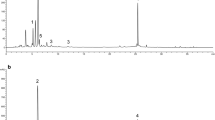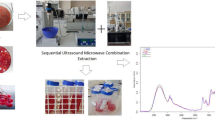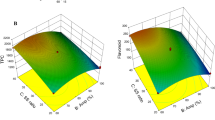Abstract
The aim of this study was to compare different techniques in order to achieve a high extraction of phenolic compounds from propolis. For this purpose, it was investigated the use of double maceration (24 h at room temperature with continuous agitation at 250 rpm), double microwave treatments (1 min at 140 W) and double ultrasound-assisted extraction (15 min at 20 kHz) using 70% ethanol. The extraction efficiency was measured based on extraction yield, total phenolic content, flavones and flavonol content, and flavanone and dihydroflavonol content. The ultrasonic extraction had an extraction yield higher than microwave extraction and maceration. The yield of the propolis ranged between samples and between the years of propolis harvesting. Of the twelve quantified phenolic compounds, p-coumaric acid was the most abundant (271.65 mg/g propolis).


Similar content being viewed by others
References
Al-Ani I, Zimmermann S, Reichling J, Wink M (2018) Antimicrobial activities of european propolis collected from various geographic origins alone and in combination with antibiotics. Medicines 5(1):2
Alm-Eldeen AA, Basyony MA, Elfiky NK, Ghalwash MM (2017) Effect of the Egyptian propolis on the hepatic antioxidant defense and pro-apoptotic p53 and antiapoptotic bcl2 expressions in aflatoxin B1 treated male mice. Biomed Pharmacother 87:247–255
Antolovich M, Prenzler P, Robards K, Ryan D (2000) Sample preparation in the determination of phenolic compounds in fruits. Analyst 125(5):989–1009
Biscaia D, Ferreira SR (2009) Propolis extracts obtained by low pressure methods and supercritical fluid extraction. J Supercrit Fluids 51(1):17–23
Chen YW, Ye SR, Ting C, Yu YH (2018) Antibacterial activity of propolins from Taiwanese green propolis. J Food Drug Anal 26(2):761–768
Coneac G, Gafiţanu E, Hădărugă DI et al (2008) Flavonoid contents of propolis from the west side of Romania and correlation with the antioxidant activity. Chem Bull Politeh Uni Timis 53(67):56–60
Cornara L, Biagi M, Xiao J, Burlando B (2017) Therapeutic properties of bioactive compounds from different honeybee products. Front Pharmacol 8:412
Cottica SM, Sabik H, Antoine C et al (2015) Characterization of Canadian propolis fractions obtained from two-step sequential extraction. LWT Food Sci Technol 60(1):609–614
Cruz M, Antunes P, Paulo L et al (2016) Antioxidant and dual dose-dependent antigenotoxic and genotoxic properties of an ethanol extract of propolis. RSC Adv 6(55):49806–49816
Di Capua A, Bejarano A, Adami R, Reverchon E (2018) Preparation and characterization of Chilean propolis coprecipitates using supercritical assisted atomization. Chem Eng Res Des 136:776–785
Dranca F, Oroian M (2016) Optimization of ultrasound-assisted extraction of total monomeric anthocyanin (TMA) and total phenolic content (TPC) from eggplant (Solanum melongena L.) peel. Ultrason Sonochem 31:637–646
Escriche I, Juan-Borrás M (2018) Standardizing the analysis of phenolic profile in propolis. Food Res Int 106:834–841
Falcão SI, Vilas-Boas M, Estevinho LM et al (2010) Phenolic characterization of Northeast Portuguese propolis: usual and unusual compounds. Anal Bioanal Chem 396(2):887–897
Falcão SI, Vale N, Cos P et al (2014) In vitro evaluation of Portuguese propolis and floral sources for antiprotozoal, antibacterial and antifungal activity. Phytother Res 28(3):437–443
Freitas JA, Vanat N, Pinheiro JW et al (2011) The effects of propolis on antibody production by laying hens. Poult Sci 90(6):1227–1233
González M, Guzmán B, Rudyk R et al (2003) Spectrophotometric determination of phenolic compounds in propolis. Acta Farm Bonaer 22(3):243–248
Jug M, Končić MZ, Kosalec I (2014) Modulation of antioxidant, chelating and antimicrobial activity of poplar chemo-type propolis by extraction procures. LWT Food Sci Technol 57(2):530–537
Kumazawa S, Hamasaka T, Nakayama T (2004) Antioxidant activity of propolis of various geographic origins. Food Chem 84(3):329–339
Liu Z, Ding L, Zhang H, Hu X, Bu F (2006) Comparison of the different extraction methods of flavonoids in Epimedium Koreamum Nakai by HPLC–DAD–ESI–MSn. J Liq Chromatogr Relat Technol 29(5):719–731
Marcucci MC (1995) Propolis: chemical composition, biological properties and therapeutic activity. Apidologie 26(2):83–99
Meimandi-Parizi A, Oryan A, Sayahi E, Bigham-Sadegh A (2018) Propolis extract a new reinforcement material in improving bone healing: an in vivo study. Int J Surg 56:94–101
Mokrani A, Madani K (2016) Effect of solvent, time and temperature on the extraction of phenolic compounds and antioxidant capacity of peach (Prunus persica L.) fruit. Sep Purif Technol 161:68–76
Moreira L, Dias LG, Pereira JA, Estevinho L (2008) Antioxidant properties, total phenols and pollen analysis of propolis samples from Portugal. Food Chem Toxicol 46(11):3482–3485
Nna VU, Bakar ABA, Mohamed M (2018) Malaysian propolis, metformin and their combination, exert hepatoprotective effect in streptozotocin-induced diabetic rats. Life Sci 211:40–50
Oliveira AV, Ferreira AL, Nunes S et al (2017) Antibacterial activity of propolis extracts from the south of Portugal. Pak J Pharm Sci 30(1):1–9
Oroian M (2012) Physicochemical and rheological properties of Romanian honeys. Food Biophys 7(4):296–307
Oroian M, Ropciuc S (2017) Honey authentication based on physicochemical parameters and phenolic compounds. Comput Electron Agric 138:148–156
Ozdal T, Sari-Kaplan G, Mutlu-Altundag E et al (2018) Evaluation of Turkish propolis for its chemical composition, antioxidant capacity, anti-proliferative effect on several human breast cancer cell lines and proliferative effect on fibroblasts and mouse mesenchymal stem cell line. J Apic Res 57:1–12
Popova MP, Bankova VS, Bogdanov S et al (2007) Chemical characteristics of poplar type propolis of different geographic origin. Apidologie 38(3):306–311
Popova M, Trusheva B, Bankova V (2017) Content of biologically active compounds in Bulgarian propolis: a basis for its standardization. Bulg Chem Commun 49:115–120
Roh J, Kim KR (2018) Antimicrobial activity of Korean propolis extracts on oral pathogenic microorganisms. J Dent Hyg Sci 18(1):18–23
Sawaya ACHF, da Silva Cunha IB, Marcucci MC (2011) Analytical methods applied to diverse types of Brazilian propolis. Chem Cent J 5(1):27
Sforcin JM (2016) Biological properties and therapeutic applications of propolis. Phytother Res 30(6):894–905
Sforci JM, Bankova V (2011) Propolis: is there a potential for the development of new drugs? J Ethnopharmacol 133(2):253–260
Sheng J, Zhou J, Wang L et al (2007) Antioxidant activity of ethanol and petroleum ether extracts from Brazilian propolis. Eur Food Res Technol 225(2):249–253
Silva-Carvalho R, Miranda-Gonçalves V, Ferreira AM et al (2014) Antitumoural and antiangiogenic activity of Portuguese propolis in in vitro and in vivo models. J Funct Foods 11:160–171
Silva-Carvalho R, Baltazar F, Almeida-Aguiar C (2015) Propolis: a complex natural product with a plethora of biological activities that can be explored for drug development. Evid Based Complement Altern Med 2015:206439
Stan L, Mărghitaş LA, Dezmirean D (2011) Quality criteria for propolis standardization. Sci Pap Anim Sci Biotechnol 44(2):137–140
Thamnopoulos IAI, Michailidis GF, Fletouris DJ et al (2018) Inhibitory activity of propolis against Listeria monocytogenes in milk stored under refrigeration. Food Microbiol 73:168–176
Trusheva B, Trunkova D, Bankova V (2007) Different extraction methods of biologically active components from propolis: a preliminary study. Chem Cent J 1(1):13
Veloz JJ, Saavedra N, Lillo A et al (2015) Antibiofilm activity of Chilean propolis on Streptococcus mutans is influenced by the year of collection. BioMed Res Int, Article ID 291351
Yildirim A, Duran GG, Duran N et al (2016) Antiviral activity of hataypropolis against replication of herpes simplex virus type 1 and type 2. Med Sci Monit 22:422–430
Acknowledgements
This project is co-funded by the Ministry of Research and Innovation through Program 1—Development of the National R&D System, Subprogram 1.2—Institutional Performance—Projects for Excellence Financing in RDI, Contract No.18PFE/2018 and by the Romania National Council for Higher Education Funding, CNFIS, project number CNFIS-FDI-2019-0600.
Author information
Authors and Affiliations
Corresponding author
Additional information
Publisher's Note
Springer Nature remains neutral with regard to jurisdictional claims in published maps and institutional affiliations.
Rights and permissions
About this article
Cite this article
Oroian, M., Dranca, F. & Ursachi, F. Comparative evaluation of maceration, microwave and ultrasonic-assisted extraction of phenolic compounds from propolis. J Food Sci Technol 57, 70–78 (2020). https://doi.org/10.1007/s13197-019-04031-x
Revised:
Accepted:
Published:
Issue Date:
DOI: https://doi.org/10.1007/s13197-019-04031-x




